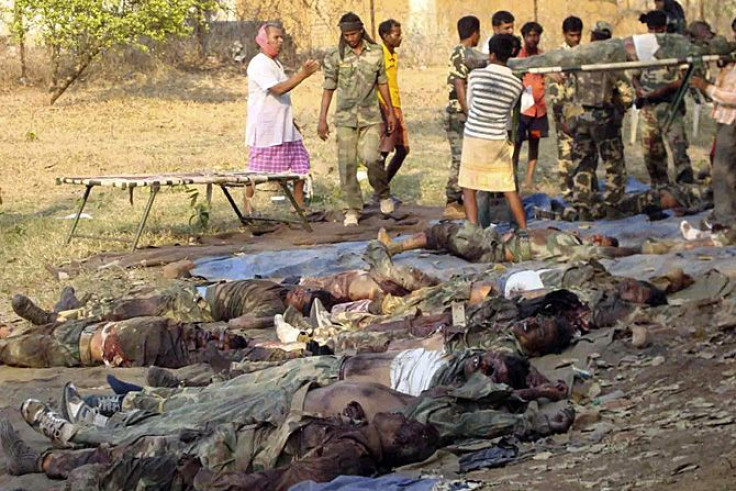Blood Red Corridor: Maoist Rebels Kill Seven Policemen In Chhattisgarh, India

Maoist militants in the central-eastern Indian province of Chhattisgarh have killed at least seven policemen, stoking fears that a multi-decade Communist terrorist movement may escalate ahead of national elections scheduled for May. The policemen, including a sub-inspector, were in transit on motorcycles towards the Dantewada district to provide security for workers constructing a road when militants detonated land mines and ambushed them. Another two police officers were wounded in the attack, a senior police officer named Mukesh Gupta told BBC. The Maoist militants also seized the weaponry of the fallen officers. “The Maoists walked away with AK-47s of the dead policemen,” Datewada’s superintendent of police Narendra Khare told Indo-Asian News Service (IANS). Reportedly, dozens of Maoists were involved in the horrific ambush.
Raman Singh, the chief minister of Chhattisgarh, condemned the attack as an act of “cowardice” by the Maoists. India Today reported that immediately after the attack, security forces were deployed to the densely forested and hilly area to search for the killers.
According to the Times of India, the massacre occurred in the Shyamgiri hills of the tribal Bastar region, which is a stronghold for Maoist guerrilla activity. In fact, Dantewada is located in the very heart of the so-called “Red Corridor,” a swath of central and northeastern India where Maoists have waged a violent insurgency campaign against the state allegedly on behalf of landless laborers, the poor and tribal people who proliferate in the largely impoverished rural region. This corridor, which include parts of the states Andhra Pradesh, Bihar, Chattisgarh, Jharkhand, Madhya Pradesh, Orissa, Uttar Pradesh and West Bengal, feature high levels of poverty and illiteracy. In April 2010, Maoists rebels killed 75 Indian soldiers in a flurry of attacks on military convoys in Dantewada. The following month, Naxalites killed almost four dozen police officers and civilians traveling on a bus through Dantewada.
Thousands of the people have died in India over the past four-plus decades of violence between Maoist guerrillas and the Indian government, primarily in West Bengal. Inspired by the Communist revolution of Chairman Mao Tse-Tung of China, the Maoists have demanded land and jobs for impoverished farmers and the poor. The militants are also called ‘Naxalites,’ in honor of the West Bengal village of Naxalbari where the group was founded in 1967. They claim they represent the rights and interests of the rural poor and landless workers against the federal government. They also want India to become a Communist state.
Reportedly, the Naxalite movement at one time had as many as 20,000 fighters, principally in eastern India, but also in the central part of the country. Naxalite violence peaked in the 1970s before the government crushed it. Manmohan Singh, India's prime minister, has described the group as a major strategic security threat to the country.
Dr. Michael Kugelman, a scholar and expert on South Asia, also called the Maoists a “bona fide threat” to India, but cautioned that since the number and intensity of Communist attacks have decreased in recent years, “I think it's wrong to describe it, as New Delhi does, as India's most serious internal security challenge.” Kugelman, who is senior program associate for South and Southeast Asia at the Woodrow Wilson International Center for Scholars in Washington, explained that the Naxalites flourish in India because they exploit the very sharp class divides and economic inequalities most discernable in India's hinterland. “Many tribal peoples in Chhattisgarh and elsewhere in central and eastern India resent how the Indian government and private corporations engage in heavy resource extractions (particularly of coal) that causes horrible pollution, displaces locals and leads to long-term health problems for locals,” he said. “The fact that these areas of India are so poor and underdeveloped, and that these resource extractions are not shared equitably with locals, helps fuel the insurgency.”
Dr. Jonah Blank, senior political scientist at the RAND Corporation, explained that the Naxalites draw their strength from deeply-felt grievances rather than from Maoist ideology. “Their base of support -- Adivasis [tribals] and other downtrodden communities-- doesn't care about Marxism, only about protection from higher-caste adversaries,” he explained.
In addition, Kugelman noted, the Naxalite insurgency has likely been intensified by heavy-handed state uses of force, including the formation of local paramilitaries that burn down houses, abuse local people and carry out many other vile actions in Naxalite bastions. “Such responses have been toned down significantly in the last year or two -- and not surprisingly, the insurgency has been quieter ever since,” Kugelman said.
Kugelman further cautions that the Naxalites should not be linked to the established Communist political parties (which, ironically, had long ruled West Bengal until recently). “The only connections between the Naxalites and more mainstream Communist parties in India would be ideological,” he commented. “The mainstream groups don't support the violence used by the Naxalites, and they are careful to distance themselves from them.”
Indeed, Blank noted that when the Communist Party ruled West Bengal, the Naxalites launched many attacks in the state.
© Copyright IBTimes 2024. All rights reserved.











